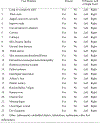Foot Health Assessment and Problem Identification in a Dominican Batey Community: A Descriptive Study
- PMID: 33290018
- PMCID: PMC7727270
- DOI: 10.1097/WON.0000000000000664
Foot Health Assessment and Problem Identification in a Dominican Batey Community: A Descriptive Study
Abstract
Purpose: Foot problems can adversely impact foot function and quality of life. Foot problems are often overlooked, particularly in populations with limited health care access. Little is known about the foot health of Haitian immigrants who live and work in the bateyes (rural sugarcane villages) of the Dominican Republic. These immigrant workers may experience foot problems that could affect foot function and the ability to work and provide for their families.
Design: Cross-sectional, exploratory, descriptive study design.
Subjects and setting: A convenience sample of adults was recruited from an ongoing community-based participatory research project evaluating a mobile hypertension screening and treatment clinic program in 11 Dominican batey communities.
Methods: Foot health was assessed using the Foot Problems Checklist, a 24-item survey instrument developed for this study based on a review of the literature and foot clinician expertise. A certified foot care nurse recorded foot health data on the Foot Problems Checklist via visual and physical inspection.
Results: Study participants were 25 females and 16 males, aged 18 to 90 years, and all had at least one foot health problem. The most common foot problems were calluses (78%), dry skin (76%), thick nails (59%), jagged nails (29%), long/overgrown nails (17%), and skin fissures (12%).
Conclusions: While the foot problems we observed were not considered serious, they could become progressively debilitating and be prevented with proper self-management guided by appropriate knowledge and skills and available supplies. We recommend the development and testing of foot care self-management interventions deliverable via mobile clinics to increase access and improve foot health outcomes.
Conflict of interest statement
The authors declare no conflict of interest.
Figures
Similar articles
-
Prevalence of malaria and lymphatic filariasis in bateyes of the Dominican Republic.Infect Dis Poverty. 2019 May 27;8(1):39. doi: 10.1186/s40249-019-0547-3. Infect Dis Poverty. 2019. PMID: 31130142 Free PMC article.
-
Perceived discrimination in bateyes of the Dominican Republic: results from the Everyday Discrimination Scale and implications for public health programs.BMC Public Health. 2019 Nov 12;19(1):1513. doi: 10.1186/s12889-019-7773-2. BMC Public Health. 2019. PMID: 31718594 Free PMC article.
-
Enhancing Diabetes Health Outcomes Among Haitian Migrants Living in Dominican Bateyes.Sci Diabetes Self Manag Care. 2023 Aug;49(4):281-290. doi: 10.1177/26350106231178838. Epub 2023 Jun 14. Sci Diabetes Self Manag Care. 2023. PMID: 37313730
-
The Jonas Hypertension Program: An Academic-Community Partnership to Address Hypertension in Four Dominican Bateyes.Hisp Health Care Int. 2019 Mar;17(1):11-17. doi: 10.1177/1540415318819487. Epub 2018 Dec 27. Hisp Health Care Int. 2019. PMID: 30590947
-
Osteochondroses and apophyseal injuries of the foot in the young athlete.Curr Sports Med Rep. 2010 Sep-Oct;9(5):265-8. doi: 10.1249/JSR.0b013e3181f19488. Curr Sports Med Rep. 2010. PMID: 20827090 Review.
References
-
- Institute for Preventative Foot Health. National foot health assessment. Statesville, NC: Institute for Preventative Foot Health, 2012. https://www.ipfh.org/images/research_materials/2012_National_Foot_Health...
MeSH terms
Grants and funding
LinkOut - more resources
Full Text Sources
Medical



